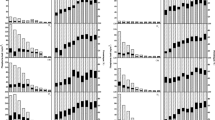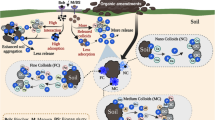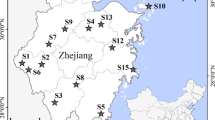Abstract
Purpose
Colloid-facilitated phosphorus (P) has been proved as a significant contributor to eutrophication. Release of colloidal phosphorus (Pcoll) depends on the released soil colloids and their P adsorption abilities, both of which are greatly affected by pH. The aim of the study was to assess the effect of pH in a wide range on Pcoll loss of the top silt loamy soil rich in organic matter and P for the successful description and prediction of P transport.
Materials and methods
In batch experiment, soil samples were shaken with deionized water in a wide range of pH from 1.4 to 9.9 for 24 h. Then water-dispersible colloids (WDCs) were extracted by pre-centrifugation, microfiltration, and ultracentrifugation processes orderly and determined gravimetrically. The Pcoll values at each pH were calculated as the difference between the concentration of total P in non-ultracentrifuged and ultracentrifuged samples. The same method was applied for the released colloidal mineral elements (Al, Fe, Ca, Si, Mg, Mn). Colloid morphology and P distribution on colloid surface were directly illustrated by transmission electron microscope (TEM) and scanning electron microscope-energy-dispersive X-ray spectroscopy (SEM-EDS) mapping scanning analyses.
Results and discussion
Over pH 4.6–6.0, the released Pcoll was below 5.5 mg kg–1 soil, while up to 66.8 mg kg–1 soil and 28.5 mg kg–1 soil at pH 1.4 and 9.9, respectively, indicating that both high and low pH values enhanced the mobilization of Pcoll. At the low pH, the potential loss of Pcoll mainly resulted from the dissolution of inorganic encasing cement such as Al oxides and clay mineral. However, besides electrostatic repulsion, dissolution of organic coating at high pH enhanced the Pcoll release as revealed by the SEM-EDS results. The P was heterogeneously distributed on the WDCs and might be associated with soil organic matter, Al oxides, Fe oxides (oxyhydroxide), and clay mineral at the low pH, while mainly with Fe oxides and less clay mineral at the high pH.
Conclusions
Both high and low pH enhanced colloid and Pcoll releases. This study first visually revealed that the dissolution of organic cement at high pH enhanced the release of WDCs and their facilitated Pcoll release. The exceptional loss risk of Pcoll may be caused by soil acidification due to the dissolution of inorganic cements, especially in Al-rich soils, and by the enhanced high soil pH due to the dissolution of organic coating in the organic matter-rich soils.




Similar content being viewed by others
References
Bunn RA, Magelky RD, Ryan JN, Elimelech M (2002) Mobilization of natural colloids from an iron oxide-coated sand aquifer: effect of pH and ionic strength. Environ Sci Technol 36:314–322
Celi L, Presta M, Ajmore-Marsan F, Barberis E (2001) Effects of pH and electrolytes on inositol hexaphosphate interaction with goethite. Soil Sci Soc Am J 65:753–760
Filella M, Deville C, Chanudet V, Vignati D (2006) Variability of the colloidal molybdate reactive phosphorous concentrations in freshwaters. Water Res 40:3185–3192
Guan XH, Shang C, Chen GH (2006) Competitive adsorption of organic matter with phosphate on aluminum hydroxide. J Colloid Interface Sci 296:51–58
Heathwaite L, Haygarth P, Matthews R, Preedy N, Butler P (2005) Evaluating colloidal phosphorus delivery to surface waters from diffuse agricultural sources. J Environ Qual 34:287–298
Hens M, Merckx R (2002) The role of colloidal particles in the speciation and analysis of “dissolved” phosphorus. Water Res 36:1483–1492
Hu SP, Chen XC, Shi JY, Chen YX, Lin Q (2008) Particle-facilitated lead and arsenic transport in abandoned mine sites soil influenced by simulated acid rain. Chemosphere 71:2091–2097
Hudson JJ, Taylor WD, Schindler DW (2000) Phosphate concentrations in lakes. Nature 406:54–56
Ilg K, Siemens J, Kaupenjohann M (2005) Colloidal and dissolved phosphorus in sandy soils as affected by phosphorus saturation. J Environ Qual 34:926–935
Ilg K, Dominik P, Kaupenjohann M, Siemens J (2008) Phosphorus-induced mobilization of colloids: model systems and soils. Eur J Soil Sci 59:233–246
Karathanasis AD, Shumaker PD (2009) Organic and inorganic phosphate interactions with soil hydroxy-interlayered minerals. J Soils Sediments 9:501–510
Kjaergaard C, Hansen HCB, Koch CB, Villholth KG (2004) Properties of water-dispersible colloids from macropore deposits and bulk horizons of an Agrudalf. Soil Sci Soc Am J 68:1844–1852
Klitzke S, Lang F, Kaupenjohann M (2008) Increasing pH releases colloidal lead in a highly contaminated forest soil. Eur J Soil Sci 59:265–273
Li S, Li H, Liang XQ, Chen YX, Cao ZH, Xu ZH (2009) Rural wastewater irrigation and nitrogen removal by the paddy wetland system in the Tai Lake region of China. J Soils Sediments 9:433–442
Liang T, Wang H, Kung HT, Zhang CS (2004) Agriculture land-use effects on nutrient losses in West Tiaoxi watershed, China. J Am Water Resour Assoc 40:1499–1510
Lu RK (1999) Analytical methods of soil and agricultural chemistry. China Agricultural Science and Technology Press, Beijing
Makarov MI, Malysheva TI (2006) Phosphorus in humus acids. Eurasian Soil Sci 39:1208–1216
Martinez CM, Fernandez-Marcos ML, Rodriguez EA (1996) Factors influencing phosphorus adsorption in mine soils in Galicia, Spain. Sci Total Environ 180:137–145
McGechan MB, Lewis DR (2002) Sorption of phosphorus by soil: Part 1. Principles, equations and models. Biosyst Eng 82:1–24
Moreira CS, Casagrande JC, Alleoni LRF, de Camargo OA, Berton RS (2008) Nickel adsorption in two Oxisols and an Alfisol as affected by pH, nature of the electrolyte, and ionic strength of soil solution. J Soils Sediments 8:442–451
Pagel H, Ilg K, Siemens J, Kaupenjohann M (2008) Total phosphorus determination in colloid-containing soil solutions by enhanced persulfate digestion. Soil Sci Soc Am J 72:786–790
Panagopoulos I, Mimikou M, Kapetanaki M (2007) Estimation of nitrogen and phosphorus losses to surface water and groundwater through the implementation of the SWAT model for Norwegian soils. J Soils Sediments 7:223–231
Ryan JN, Gschwend PM (1994) Effect of solution chemistry on clay colloid release from an iron oxide-coated aquifer sand. Environ Sci Technol 28:1717–1726
Sato S, Neves EG, Solomon D, Liang BQ, Lehmann J (2009) Biogenic calcium phosphate transformation in soils over millennial time scales. J Soils Sediments 9:194–205
Schelde K, de Jonge LW, Kjaergaard C, Laegdsmand M, Rubaek GH (2006) Effects of manure application and plowing on transport of colloids and phosphorus to tile drains. Vadose Zone J 5:445–458
Seta AK, Karathanasis AD (1996) Water dispersible colloids and factors influencing their dispersibility from soil aggregates. Geoderma 74:255–266
Shand CA, Smith S, Edwards AC, Fraser AR (2000) Distribution of phosphorus in particulate, colloidal and molecular-sized fractions of soil solution. Water Res 34:1278–1284
Siemens J, Ilg K, Lang F, Kaupenjohann M (2004) Adsorption controls mobilization of colloids and leaching of dissolved phosphorus. Eur J Soil Sci 55:253–263
Siemens J, Ilg K, Pagel H, Kaupenjohann M (2008) Is colloid-facilitated phosphorus leaching triggered by phosphorus accumulation in sandy soils? J Environ Qual 37:2100–2107
Slowey AJ, Johnson SB, Rytuba JJ, Brown GE (2005) Role of organic acids in promoting colloidal transport of mercury from mine tailings. Environ Sci Technol 39:7869–7874
Swartz CH, Gschwend PM (1998) Mechanisms controlling release of colloids to groundwater in a Southeastern Coastal Plain aquifer sand. Environ Sci Technol 32:1779–1785
Tilman D, Fargione J, Wolff B, D’Antonio C, Dobson A, Howarth R, Schindler D, Schlesinger WH, Simberloff D, Swackhamer D (2001) Forecasting agriculturally driven global environmental change. Science 292:281–284
Turner BL, Kay MA, Westermann DT (2004) Colloidal phosphorus in surface runoff and water extracts from semiarid soils of the western United States. J Environ Qual 33:1464–1472
Ussiri DAN, Johnson CE (2004) Sorption of organic carbon fractions by Spodosol mineral horizons. Soil Sci Soc Am J 68:253–262
Xi BD, Xu HD, Huo LH, Wang JG (2007) Effect of pH on retention of N and P in ditch sediments. Environ Pollut Control 29(7):490–494
Zhang MK, He ZL, Calvert DV, Stoffella PJ (2003) Colloidal iron oxide transport in sandy soil induced by excessive phosphorus application. Soil Sci 168:617–626
Zhou AM, Tang HX, Wang DS (2005) Phosphorus adsorption on natural sediments: modeling and effects of pH and sediment composition. Water Res 39:1245–1254
Acknowledgements
This work was supported by one of the major projects on the control and rectification of water body pollution of China, the Tiao River, Taihu Lake Basin agricultural non-point source pollution of rivers comprehensive harnessing technology integration and demonstration projects (2008ZX07101-006), the National Natural Science Foundation of China (40901142), and the Science Foundation of Chinese University (KYJD09021 & 2009QNA6010). Zhihong Xu also received funding support from the Australian Research Council.
Author information
Authors and Affiliations
Corresponding author
Additional information
Responsible editor: Hong Jie Di
Rights and permissions
About this article
Cite this article
Liang, X., Liu, J., Chen, Y. et al. Effect of pH on the release of soil colloidal phosphorus. J Soils Sediments 10, 1548–1556 (2010). https://doi.org/10.1007/s11368-010-0275-6
Received:
Accepted:
Published:
Issue Date:
DOI: https://doi.org/10.1007/s11368-010-0275-6




